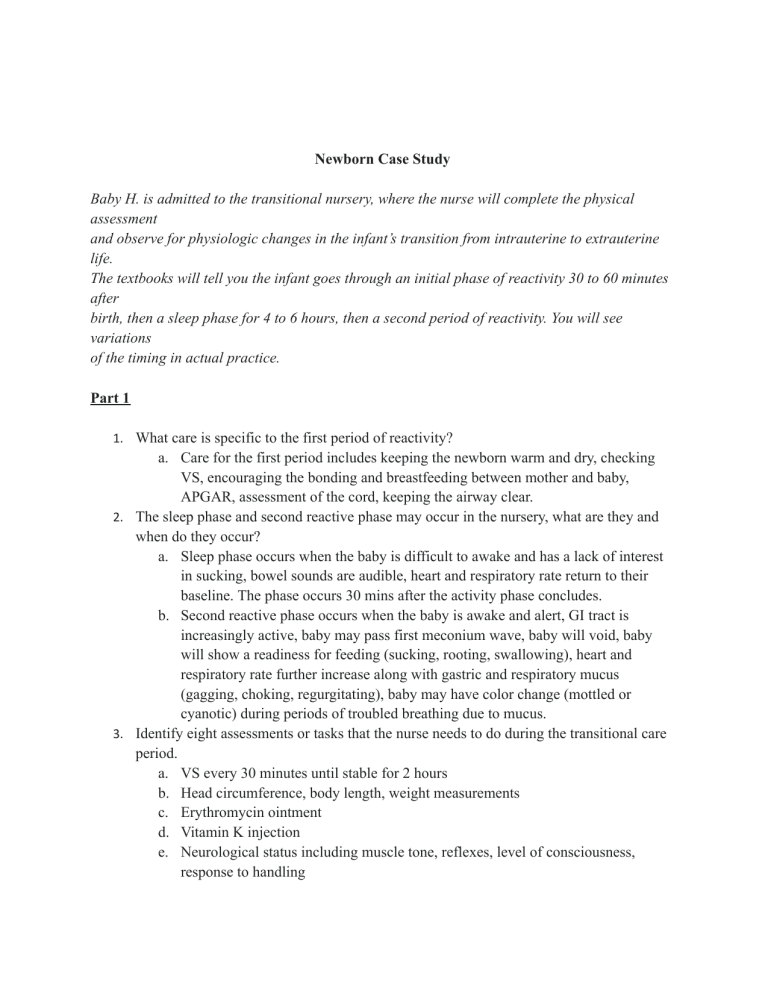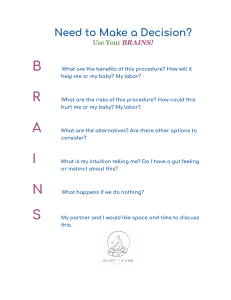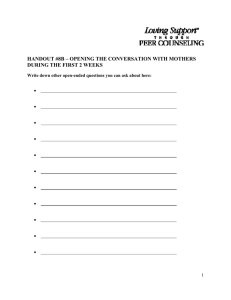
Newborn Case Study Baby H. is admitted to the transitional nursery, where the nurse will complete the physical assessment and observe for physiologic changes in the infant’s transition from intrauterine to extrauterine life. The textbooks will tell you the infant goes through an initial phase of reactivity 30 to 60 minutes after birth, then a sleep phase for 4 to 6 hours, then a second period of reactivity. You will see variations of the timing in actual practice. Part 1 1. What care is specific to the first period of reactivity? a. Care for the first period includes keeping the newborn warm and dry, checking VS, encouraging the bonding and breastfeeding between mother and baby, APGAR, assessment of the cord, keeping the airway clear. 2. The sleep phase and second reactive phase may occur in the nursery, what are they and when do they occur? a. Sleep phase occurs when the baby is difficult to awake and has a lack of interest in sucking, bowel sounds are audible, heart and respiratory rate return to their baseline. The phase occurs 30 mins after the activity phase concludes. b. Second reactive phase occurs when the baby is awake and alert, GI tract is increasingly active, baby may pass first meconium wave, baby will void, baby will show a readiness for feeding (sucking, rooting, swallowing), heart and respiratory rate further increase along with gastric and respiratory mucus (gagging, choking, regurgitating), baby may have color change (mottled or cyanotic) during periods of troubled breathing due to mucus. 3. Identify eight assessments or tasks that the nurse needs to do during the transitional care period. a. VS every 30 minutes until stable for 2 hours b. Head circumference, body length, weight measurements c. Erythromycin ointment d. Vitamin K injection e. Neurological status including muscle tone, reflexes, level of consciousness, response to handling f. Assess breastfeeding ability and function g. Maintain temperature homeostasis h. Assess airway and skin color Once the transitional care and documentation are completed, the infant is transferred to the normal newborn nursery. Part 2 4. What ongoing care of newborn is this nurse responsible for? a. The nurse is responsible for the assessment of VS every 6-8h, placing the baby supine for sleeping, bulb syringe suctioning as necessary, maintaining temperature regulation by use of clothing and minimal direct air exposure after baths etc., recording intake and output, weight checks at the same time each day, cord assessment, circumcision care if required. 5. What is the significance of the Coombs’ test? a. The Coombs’ test identifies if the newborn has antibody coated Rh+ RBCs. 6. The baby is lethargic and not feeding well. What should your next action be? a. The nurse should unwrap the newborn, perform a diaper change, stroke the cheek with a finger, hold the baby upright, talk to the baby, gently rub the hands and feet (these actions stimulate the baby). 7. Baby H.’s mother has decided to breast feed her infant. She asks for assistance. Identify six important points to include your teaching plan. a. The first session should last 10-20 minutes, when newborns feeding pattern becomes altered, switch breasts b. Bring baby to breast rather than leaning forward c. Position yourself in a comfortable spot with supporting pillows d. The baby should be nursing 8 times in 24 hours at the very least e. The baby needs to attach their lips to the breast, far back onto the areola and not on the nipple, you can stroke the baby's lips with the nipple to get an open mouth. f. It’s okay to ask for assistance if needed. 8. Baby H.’s mother asks you about cord care and circumcision care for her infant. What should you tell her? a. For cord care i. Wash your hands with soap and water for before and after care, keep the cord dry and exposed to air or loosely covered with clean clothes, clean the cord and the skin around it with a cotton swab or ball, clean 2-3 times per day or with each diaper change, do not touch the cord, avoid the use of bandages, no tub baths are recommended until the cord falls off, fold the diaper under the cord, check for odor/oozing/redness (infection), never pull the cord. b. For circumcision care i. Need to use new and clean washcloths to squeeze warm water over the site once per day, rinse with warm water and pat dry, apply a small amount of petroleum with every diaper change, do not touch the area, check for drainage or blood, plastibell (let fall off alone), light stick yellow drainage may form (normal). 9. You realize the baby needs follow-up (F/U) care after discharge. What should you teach the mother to help her understand the importance of regular visits? a. Followup care should be done within 48 hours of discharge which is focused on normal newborn care, assessment for hyperbilirubinemia, extreme weight loss, presence of feeding concerns, and knowledge deficits. 10. You realize that Baby H.’s mother needs information about safety issues before being discharged. What should you teach her? a. Proper use of the bulb syringe b. Always keep an eye or hand on the baby when they are out of the crib (can roll off bed/couch) c. The baby shouldn’t be left alone at any time d. Car seat safety i. Safest spot is in the middle of the back seat and the seat should be positioned to face the rare until the child reaches an appropriate age e. Never lift the baby if you’re feeling weak, faint, or unsteady f. Proper positioning of the baby on their back for sleep g. Prevent infection by washing hands with soap and water



